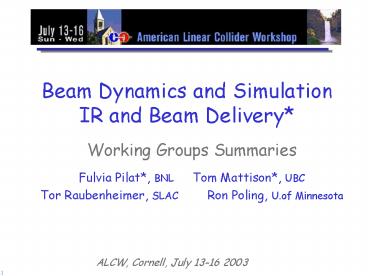Beam Dynamics and Simulation IR and Beam Delivery* - PowerPoint PPT Presentation
Title:
Beam Dynamics and Simulation IR and Beam Delivery*
Description:
Cantilevered. Across IP. Vibration Control. Inertial Feedback. Optical Feedback ... KEK comparing finite-element calcs to simple cantilever & span geometries ... – PowerPoint PPT presentation
Number of Views:43
Avg rating:3.0/5.0
Title: Beam Dynamics and Simulation IR and Beam Delivery*
1
Beam Dynamics and SimulationIR and Beam Delivery
- Working Groups Summaries
- Fulvia Pilat, BNL Tom Mattison, UBC
- Tor Raubenheimer, SLAC Ron Poling, U.of
Minnesota
ALCW, Cornell, July 13-16 2003
2
IR/Beam Delivery WG
Conveners T. Mattison, F.Pilat No time for real
review?selective/subjective summary
3
editorial comments
- IR designs are converging
- projects adopting, or at least considering,
ideas from other designs - optics, crossing angle, super-conducting quads,
vibration, collimation - Eternal questions remain (there are no solutions,
only decisions) ? trade-offs - machine luminosity - vertex detector radius
- detector acceptance and access - machine
components and supports
4
IR Issues (Markiewicz)
- Crossing Angle
- Crab Cavities
- Beam Extraction
- Physics Detector
- Beam Pipe Radius _at_ IP
- Solenoid Field
- Detector Access Model
- Energy Flexibility
- Backgrounds
- Detector Masking
- Heat / Radiation
- Final Doublet Support
- Support Tube
- Cantilevered
- Across IP
- Vibration Control
- Inertial Feedback
- Optical Feedback
- Feed-forward
- Beam-Beam Feedback
- Intra-train
- 120 Hz
- Machine Diagnostics
- Luminosity
- Energy
- Polarization
5
Second IR
- Possible to achieve very comparable luminosity,
over wide energy range - Design strategy lengthen the 2nd IR BDS (several
design iterations) reduce SR de/e in the big
bends
Seryi
6
Backgrounds
Markiewicz Seryi
- control with
- Large apertures
- beam collimators
- radiation shields
- muon spoilers
- ILC-TRC designs are
- an existence proof that
- solutions exist
SR at IP from halo
X Y plot (cm)
7
Vibrations/stabilization
- Vibrations of final quads
(Markiewicz, Partridge, Burrows) - Feedback using beam-beam deflection steering
- everyone uses it for slow drifts (many
seconds) - TESLA can do it bunch by bunch
- tests of nanosecond bunch feedback at
NLCTA - Quad position measurement and control feedback
- SLAC 6-axis feedback of block on springs
with accels electrostatic - quad and support mockup feedback project
- specialized accelerometer RD
- Rigid support tube across IP
- KEK comparing finite-element calcs to
simple cantilever span geometries - building 1/10 scale support tube prototype
8
Quadsupport mockup FBK
Partridge
9
Compact SC FF doublet
Parker
Planned warm field quality measurements, cold
quench tests
10
SC FF doublet stabilization
Parker
From RHIC BPM data (triplet cryo vibration) 200
nm (horizontal) 0 nm (vertical)
- Plans for measurements
- on cryostats and then cold masses
- Vigorous RD on vibration
- and stabilization of SC
- magnets necessary, needs
- RESOURCES ()
- COLLABORATION
11
LC Program in UK (Burrows)
- Accelerator Science Technology Centre
established in 2000 - 4M seed money for FY00-03 from PPARC UK labs
for ASTeC universities - 8 accel-related projects, 18 FTEs incl 6
students in collab with offshore labs - no time to summarize them
- 14M for FY04-05, perhaps 17M for FY04-06, for
accelerator science, "bulk" for LC - PPARC LC steering group focus on beam delivery
and machine-detector interface - Goal is to ramp up to 10 UK contribution to
LC project - (Phil says the Queen has still to sign
though.?)
12
Simulation/Dynamics WG
Conveners Raubenheimer, Poling
13
LC simulations/dynamics
- Object
- Performance ? peak luminosity (PT, Seryi)
- Reliability ? integrated luminosity (Himel)
- Level of detail
- More physics (Wolski wiggler in
DR, Bohn space charge) - Integration (Seryi DR-to-IP, 2 beams, GM BB
FBK..?luminosity) - Validation
- building blocks (Seryi? collimator wake
measurements vs.model) - X-checks, benchmarking of different codes
(Seryi, ILC-TRC) - Widening LC dynamics/simulation community
- LC simulation environment setup (Rubin
Cornell, UK, BNL.) - Simulation results database
(Burrows)
14
Reliability simulation (Himel)
Preliminary results cold machine
- Write a simulation that given the MTBFs, MTTRs,
components access requirements for repair can
calculate availability integrated luminosity - Collect component data in existing machines for
guidance - Iterate as many times as we have time to minimize
the overall cost of the LC while maintaining the
goal availability
Double tunnel
Increase MTBF
different seed
Decrease tuning time
- Interesting for existing machines
- Potential for assessing machine availability
during commissioning phase
- Different methodology (Tesla)
- FMEA (Failure Mode Effect Analysis)
- ? identify critical components
15
The devil is in the details (PT)
- Emittance growth from DFS Tesla
- Effect of jitter in NLC DFS
- Emittance growth in NLC bypass line..
- necessary to include details
- jitters, drifts, RF trips and deflections and
especially - interaction with feedback loops
- Tuning simulation on signals that will be
available in control room - ? Will be necessary to carefully develop a
commissioning strategy
16
DR gt IP lt DRintegrated simulation tools
BDS
500GeV CM
250GeV
250GeV
1.98GeV
1.98GeV
bypass
bypass
linac
linac
IP
DIMAD in Bunch Compressor and Beam
Delivery System (high order optics,
accurate particle tracking) LIAR in
Linac (wakes, fast tracking of macroparticles)
GUINEAPIG beam-beam collisions at IP PLACET or
MERLIN - in either BC, Linac or BDS
MATLABdriven
4km
17
Virtual NLC ?
1 bunch, 500 pulses takes 10 hours on 2GHz
PC (and this is with quite limited physics
included)
Real time calculations (120Hz, 192 bunch/train)
will require 300000 of 11.4GHz ideally parallel
processors
If each of them is 1cm long, they will span over
3km
Easier to build real NLC
18
Conclusion(s)
- Its a long way to go but the road is getting
paved.

